Community Health and Disease Prevention
VerifiedAdded on 2022/11/24
|12
|3104
|441
AI Summary
This essay discusses the strategies to enhance community engagement and the core domains of capacity building in the context of community health and disease prevention. It also explores different approaches to educate the community population about dengue fever.
Contribute Materials
Your contribution can guide someone’s learning journey. Share your
documents today.
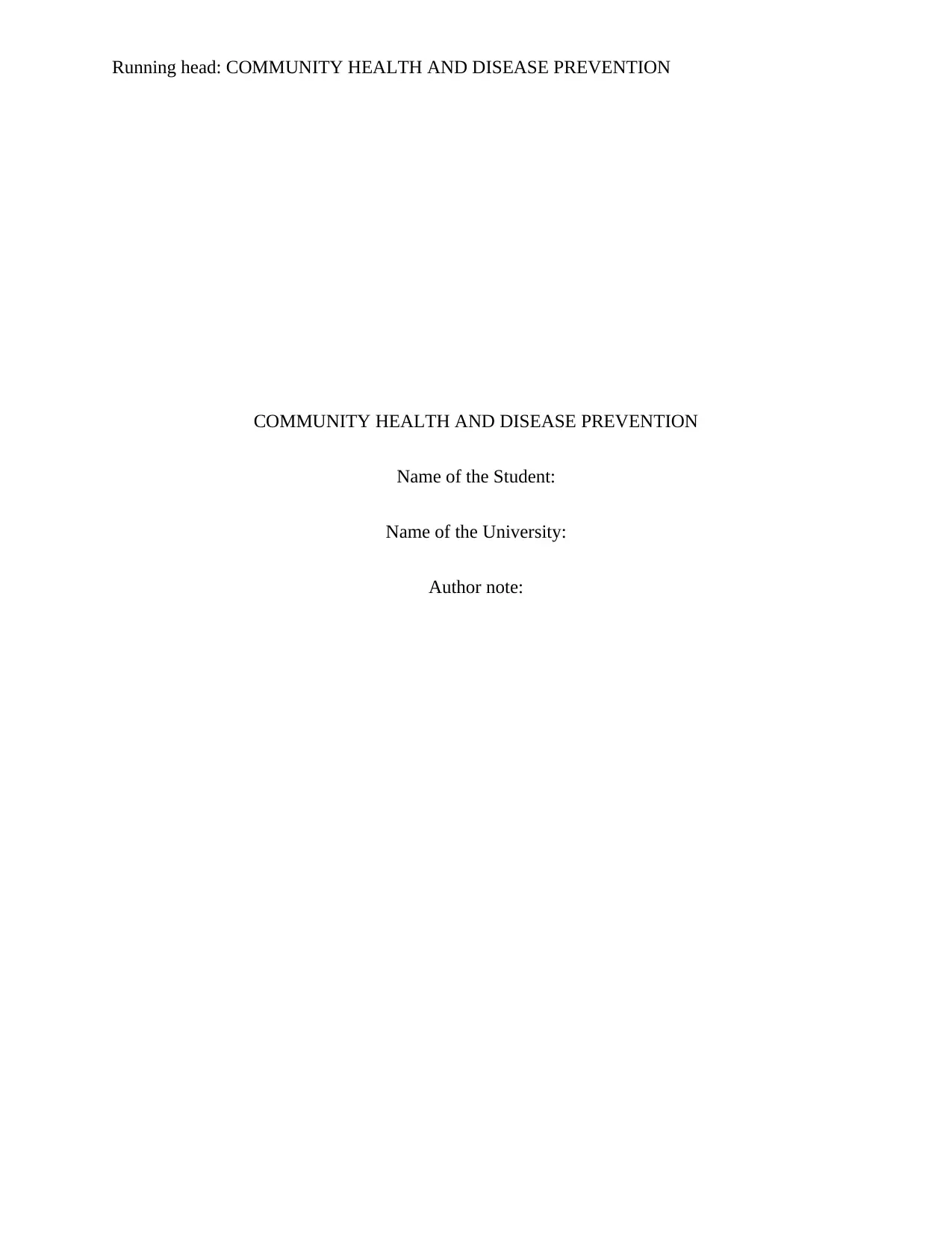
Running head: COMMUNITY HEALTH AND DISEASE PREVENTION
COMMUNITY HEALTH AND DISEASE PREVENTION
Name of the Student:
Name of the University:
Author note:
COMMUNITY HEALTH AND DISEASE PREVENTION
Name of the Student:
Name of the University:
Author note:
Secure Best Marks with AI Grader
Need help grading? Try our AI Grader for instant feedback on your assignments.
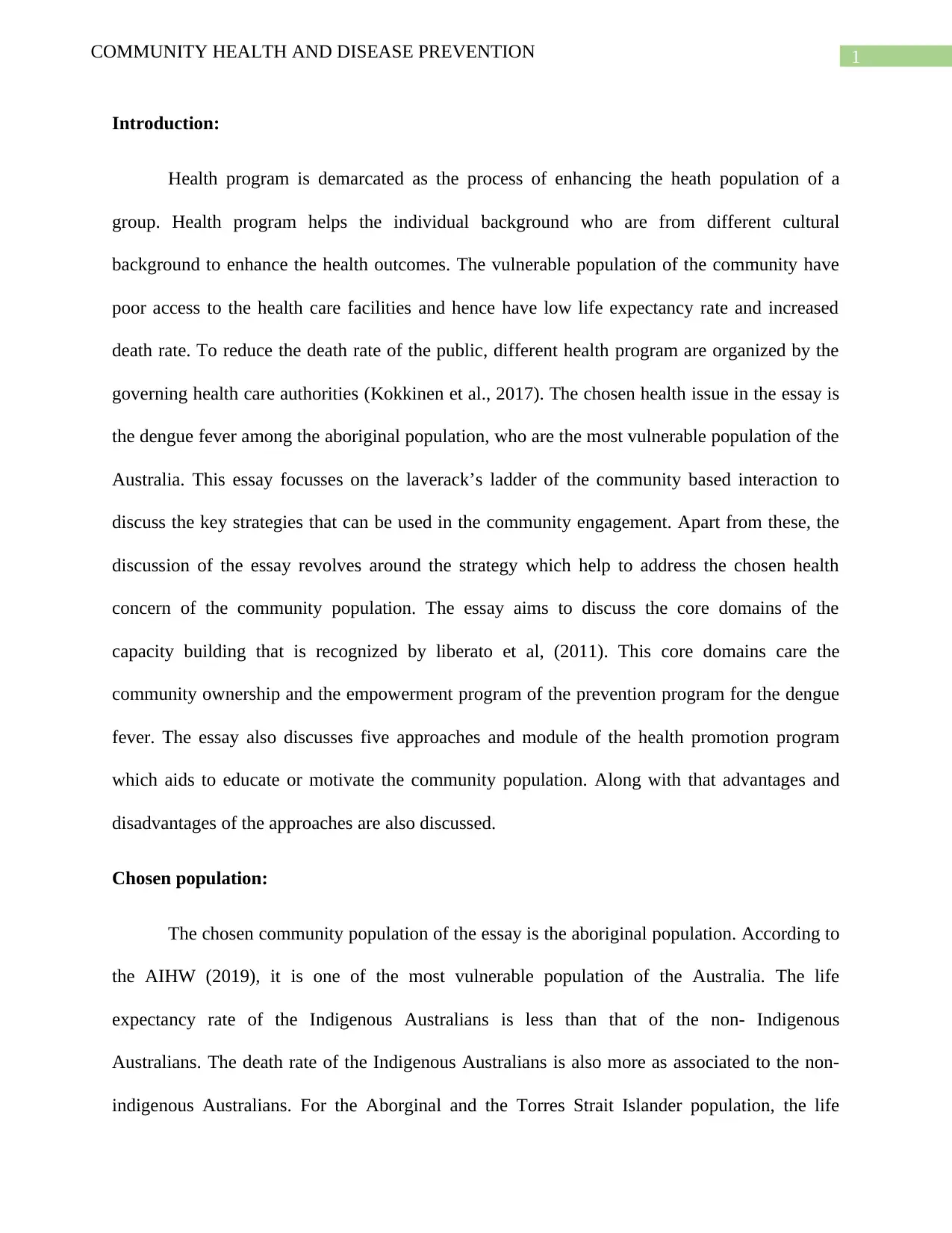
1COMMUNITY HEALTH AND DISEASE PREVENTION
Introduction:
Health program is demarcated as the process of enhancing the heath population of a
group. Health program helps the individual background who are from different cultural
background to enhance the health outcomes. The vulnerable population of the community have
poor access to the health care facilities and hence have low life expectancy rate and increased
death rate. To reduce the death rate of the public, different health program are organized by the
governing health care authorities (Kokkinen et al., 2017). The chosen health issue in the essay is
the dengue fever among the aboriginal population, who are the most vulnerable population of the
Australia. This essay focusses on the laverack’s ladder of the community based interaction to
discuss the key strategies that can be used in the community engagement. Apart from these, the
discussion of the essay revolves around the strategy which help to address the chosen health
concern of the community population. The essay aims to discuss the core domains of the
capacity building that is recognized by liberato et al, (2011). This core domains care the
community ownership and the empowerment program of the prevention program for the dengue
fever. The essay also discusses five approaches and module of the health promotion program
which aids to educate or motivate the community population. Along with that advantages and
disadvantages of the approaches are also discussed.
Chosen population:
The chosen community population of the essay is the aboriginal population. According to
the AIHW (2019), it is one of the most vulnerable population of the Australia. The life
expectancy rate of the Indigenous Australians is less than that of the non- Indigenous
Australians. The death rate of the Indigenous Australians is also more as associated to the non-
indigenous Australians. For the Aborginal and the Torres Strait Islander population, the life
Introduction:
Health program is demarcated as the process of enhancing the heath population of a
group. Health program helps the individual background who are from different cultural
background to enhance the health outcomes. The vulnerable population of the community have
poor access to the health care facilities and hence have low life expectancy rate and increased
death rate. To reduce the death rate of the public, different health program are organized by the
governing health care authorities (Kokkinen et al., 2017). The chosen health issue in the essay is
the dengue fever among the aboriginal population, who are the most vulnerable population of the
Australia. This essay focusses on the laverack’s ladder of the community based interaction to
discuss the key strategies that can be used in the community engagement. Apart from these, the
discussion of the essay revolves around the strategy which help to address the chosen health
concern of the community population. The essay aims to discuss the core domains of the
capacity building that is recognized by liberato et al, (2011). This core domains care the
community ownership and the empowerment program of the prevention program for the dengue
fever. The essay also discusses five approaches and module of the health promotion program
which aids to educate or motivate the community population. Along with that advantages and
disadvantages of the approaches are also discussed.
Chosen population:
The chosen community population of the essay is the aboriginal population. According to
the AIHW (2019), it is one of the most vulnerable population of the Australia. The life
expectancy rate of the Indigenous Australians is less than that of the non- Indigenous
Australians. The death rate of the Indigenous Australians is also more as associated to the non-
indigenous Australians. For the Aborginal and the Torres Strait Islander population, the life
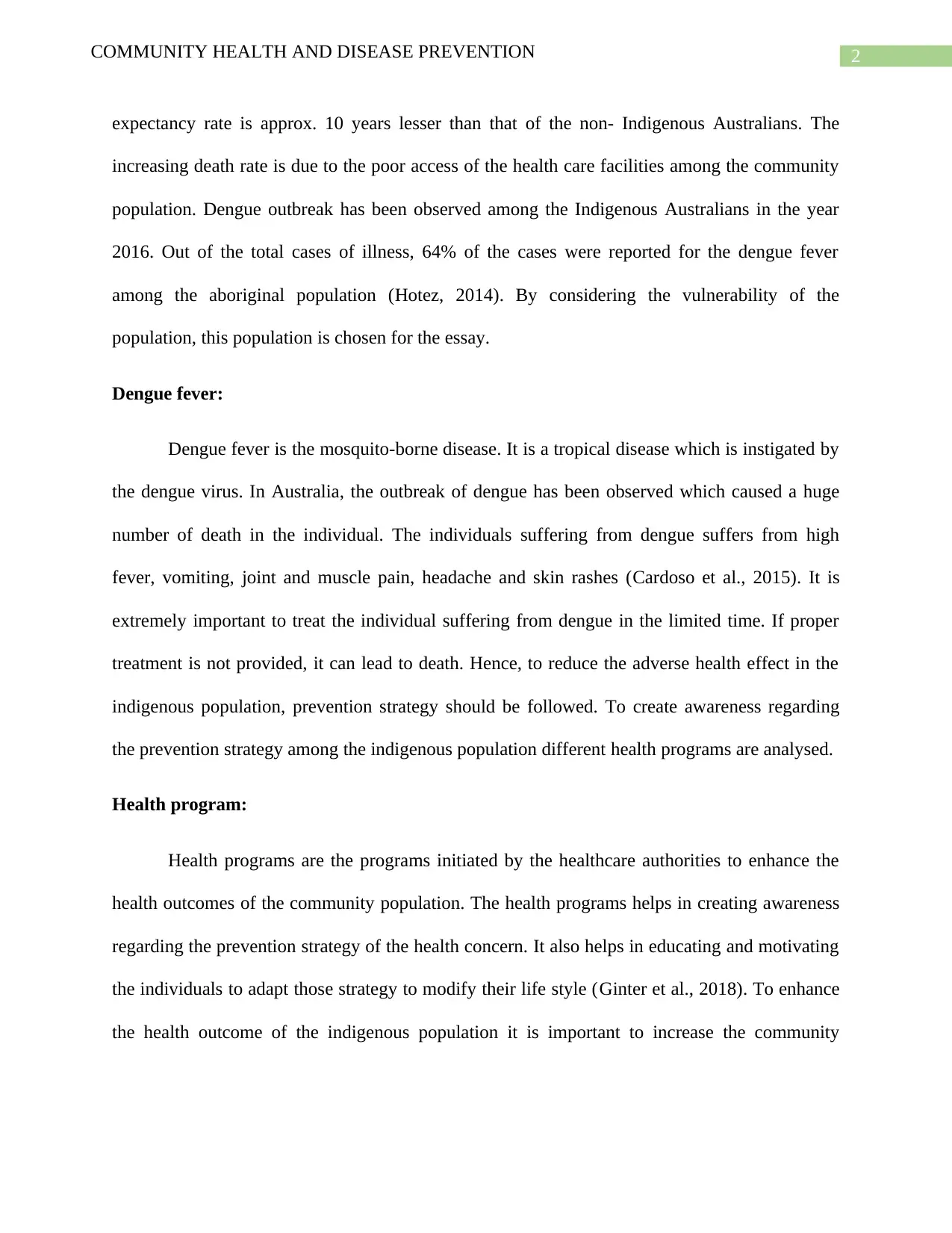
2COMMUNITY HEALTH AND DISEASE PREVENTION
expectancy rate is approx. 10 years lesser than that of the non- Indigenous Australians. The
increasing death rate is due to the poor access of the health care facilities among the community
population. Dengue outbreak has been observed among the Indigenous Australians in the year
2016. Out of the total cases of illness, 64% of the cases were reported for the dengue fever
among the aboriginal population (Hotez, 2014). By considering the vulnerability of the
population, this population is chosen for the essay.
Dengue fever:
Dengue fever is the mosquito-borne disease. It is a tropical disease which is instigated by
the dengue virus. In Australia, the outbreak of dengue has been observed which caused a huge
number of death in the individual. The individuals suffering from dengue suffers from high
fever, vomiting, joint and muscle pain, headache and skin rashes (Cardoso et al., 2015). It is
extremely important to treat the individual suffering from dengue in the limited time. If proper
treatment is not provided, it can lead to death. Hence, to reduce the adverse health effect in the
indigenous population, prevention strategy should be followed. To create awareness regarding
the prevention strategy among the indigenous population different health programs are analysed.
Health program:
Health programs are the programs initiated by the healthcare authorities to enhance the
health outcomes of the community population. The health programs helps in creating awareness
regarding the prevention strategy of the health concern. It also helps in educating and motivating
the individuals to adapt those strategy to modify their life style (Ginter et al., 2018). To enhance
the health outcome of the indigenous population it is important to increase the community
expectancy rate is approx. 10 years lesser than that of the non- Indigenous Australians. The
increasing death rate is due to the poor access of the health care facilities among the community
population. Dengue outbreak has been observed among the Indigenous Australians in the year
2016. Out of the total cases of illness, 64% of the cases were reported for the dengue fever
among the aboriginal population (Hotez, 2014). By considering the vulnerability of the
population, this population is chosen for the essay.
Dengue fever:
Dengue fever is the mosquito-borne disease. It is a tropical disease which is instigated by
the dengue virus. In Australia, the outbreak of dengue has been observed which caused a huge
number of death in the individual. The individuals suffering from dengue suffers from high
fever, vomiting, joint and muscle pain, headache and skin rashes (Cardoso et al., 2015). It is
extremely important to treat the individual suffering from dengue in the limited time. If proper
treatment is not provided, it can lead to death. Hence, to reduce the adverse health effect in the
indigenous population, prevention strategy should be followed. To create awareness regarding
the prevention strategy among the indigenous population different health programs are analysed.
Health program:
Health programs are the programs initiated by the healthcare authorities to enhance the
health outcomes of the community population. The health programs helps in creating awareness
regarding the prevention strategy of the health concern. It also helps in educating and motivating
the individuals to adapt those strategy to modify their life style (Ginter et al., 2018). To enhance
the health outcome of the indigenous population it is important to increase the community
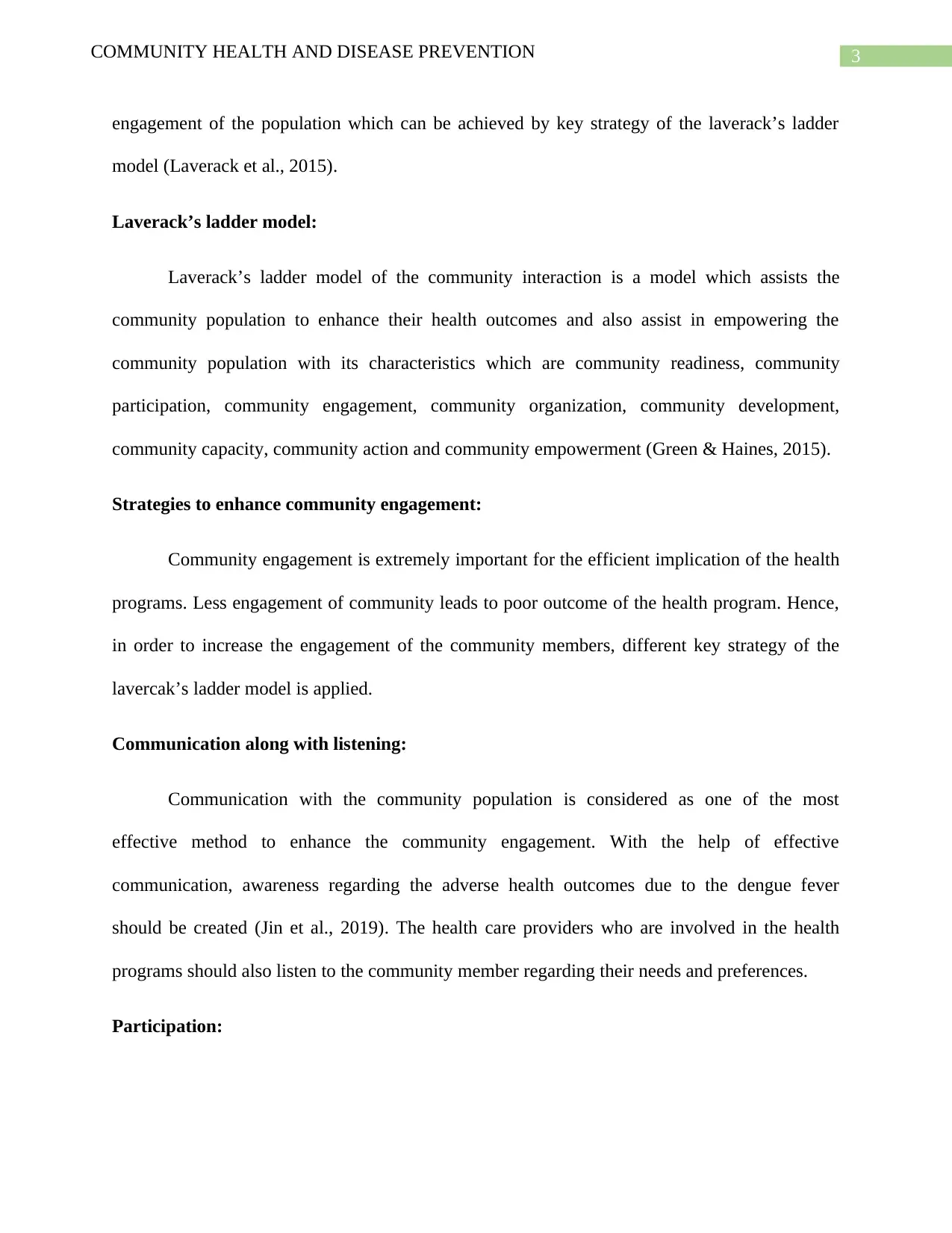
3COMMUNITY HEALTH AND DISEASE PREVENTION
engagement of the population which can be achieved by key strategy of the laverack’s ladder
model (Laverack et al., 2015).
Laverack’s ladder model:
Laverack’s ladder model of the community interaction is a model which assists the
community population to enhance their health outcomes and also assist in empowering the
community population with its characteristics which are community readiness, community
participation, community engagement, community organization, community development,
community capacity, community action and community empowerment (Green & Haines, 2015).
Strategies to enhance community engagement:
Community engagement is extremely important for the efficient implication of the health
programs. Less engagement of community leads to poor outcome of the health program. Hence,
in order to increase the engagement of the community members, different key strategy of the
lavercak’s ladder model is applied.
Communication along with listening:
Communication with the community population is considered as one of the most
effective method to enhance the community engagement. With the help of effective
communication, awareness regarding the adverse health outcomes due to the dengue fever
should be created (Jin et al., 2019). The health care providers who are involved in the health
programs should also listen to the community member regarding their needs and preferences.
Participation:
engagement of the population which can be achieved by key strategy of the laverack’s ladder
model (Laverack et al., 2015).
Laverack’s ladder model:
Laverack’s ladder model of the community interaction is a model which assists the
community population to enhance their health outcomes and also assist in empowering the
community population with its characteristics which are community readiness, community
participation, community engagement, community organization, community development,
community capacity, community action and community empowerment (Green & Haines, 2015).
Strategies to enhance community engagement:
Community engagement is extremely important for the efficient implication of the health
programs. Less engagement of community leads to poor outcome of the health program. Hence,
in order to increase the engagement of the community members, different key strategy of the
lavercak’s ladder model is applied.
Communication along with listening:
Communication with the community population is considered as one of the most
effective method to enhance the community engagement. With the help of effective
communication, awareness regarding the adverse health outcomes due to the dengue fever
should be created (Jin et al., 2019). The health care providers who are involved in the health
programs should also listen to the community member regarding their needs and preferences.
Participation:
Paraphrase This Document
Need a fresh take? Get an instant paraphrase of this document with our AI Paraphraser
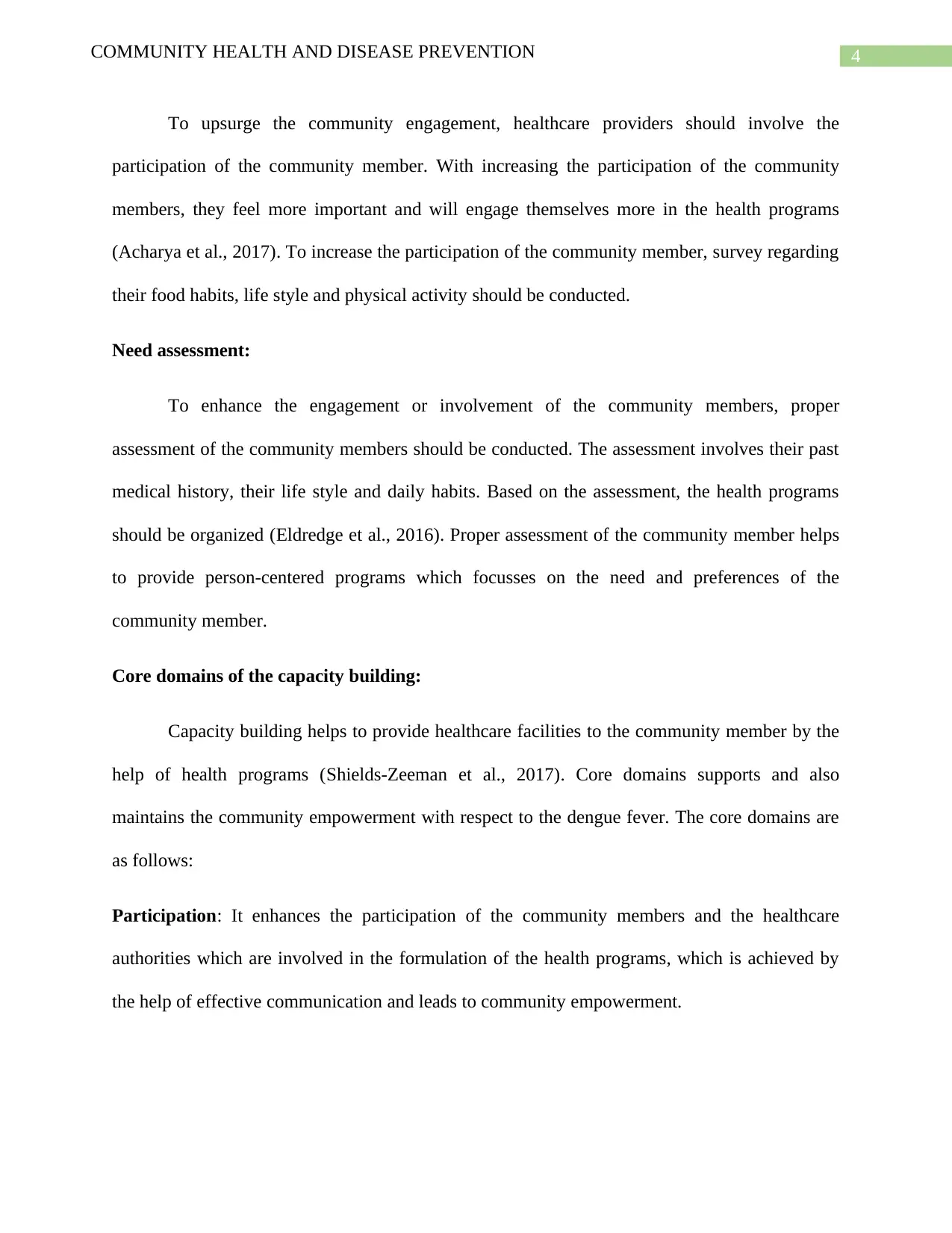
4COMMUNITY HEALTH AND DISEASE PREVENTION
To upsurge the community engagement, healthcare providers should involve the
participation of the community member. With increasing the participation of the community
members, they feel more important and will engage themselves more in the health programs
(Acharya et al., 2017). To increase the participation of the community member, survey regarding
their food habits, life style and physical activity should be conducted.
Need assessment:
To enhance the engagement or involvement of the community members, proper
assessment of the community members should be conducted. The assessment involves their past
medical history, their life style and daily habits. Based on the assessment, the health programs
should be organized (Eldredge et al., 2016). Proper assessment of the community member helps
to provide person-centered programs which focusses on the need and preferences of the
community member.
Core domains of the capacity building:
Capacity building helps to provide healthcare facilities to the community member by the
help of health programs (Shields-Zeeman et al., 2017). Core domains supports and also
maintains the community empowerment with respect to the dengue fever. The core domains are
as follows:
Participation: It enhances the participation of the community members and the healthcare
authorities which are involved in the formulation of the health programs, which is achieved by
the help of effective communication and leads to community empowerment.
To upsurge the community engagement, healthcare providers should involve the
participation of the community member. With increasing the participation of the community
members, they feel more important and will engage themselves more in the health programs
(Acharya et al., 2017). To increase the participation of the community member, survey regarding
their food habits, life style and physical activity should be conducted.
Need assessment:
To enhance the engagement or involvement of the community members, proper
assessment of the community members should be conducted. The assessment involves their past
medical history, their life style and daily habits. Based on the assessment, the health programs
should be organized (Eldredge et al., 2016). Proper assessment of the community member helps
to provide person-centered programs which focusses on the need and preferences of the
community member.
Core domains of the capacity building:
Capacity building helps to provide healthcare facilities to the community member by the
help of health programs (Shields-Zeeman et al., 2017). Core domains supports and also
maintains the community empowerment with respect to the dengue fever. The core domains are
as follows:
Participation: It enhances the participation of the community members and the healthcare
authorities which are involved in the formulation of the health programs, which is achieved by
the help of effective communication and leads to community empowerment.
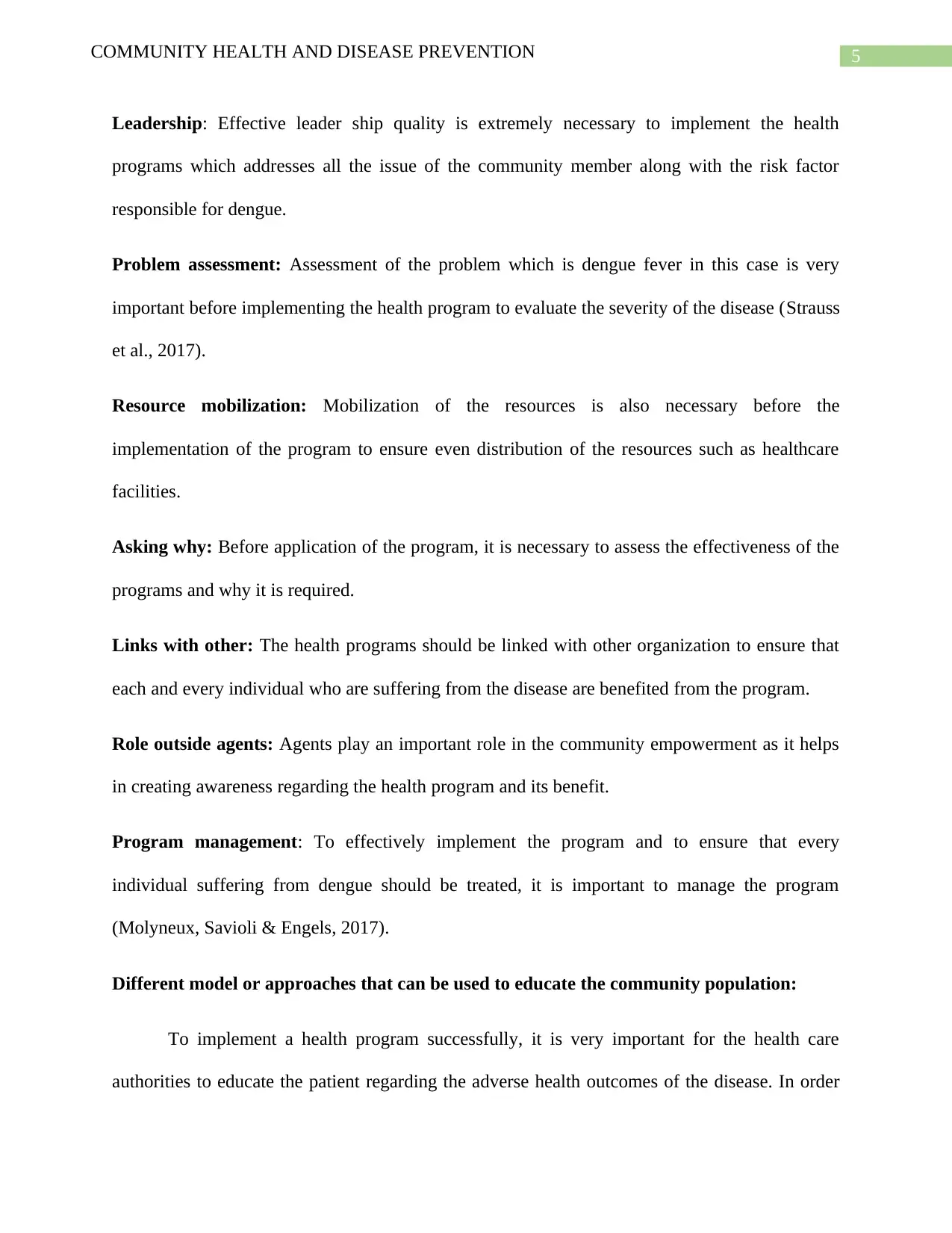
5COMMUNITY HEALTH AND DISEASE PREVENTION
Leadership: Effective leader ship quality is extremely necessary to implement the health
programs which addresses all the issue of the community member along with the risk factor
responsible for dengue.
Problem assessment: Assessment of the problem which is dengue fever in this case is very
important before implementing the health program to evaluate the severity of the disease (Strauss
et al., 2017).
Resource mobilization: Mobilization of the resources is also necessary before the
implementation of the program to ensure even distribution of the resources such as healthcare
facilities.
Asking why: Before application of the program, it is necessary to assess the effectiveness of the
programs and why it is required.
Links with other: The health programs should be linked with other organization to ensure that
each and every individual who are suffering from the disease are benefited from the program.
Role outside agents: Agents play an important role in the community empowerment as it helps
in creating awareness regarding the health program and its benefit.
Program management: To effectively implement the program and to ensure that every
individual suffering from dengue should be treated, it is important to manage the program
(Molyneux, Savioli & Engels, 2017).
Different model or approaches that can be used to educate the community population:
To implement a health program successfully, it is very important for the health care
authorities to educate the patient regarding the adverse health outcomes of the disease. In order
Leadership: Effective leader ship quality is extremely necessary to implement the health
programs which addresses all the issue of the community member along with the risk factor
responsible for dengue.
Problem assessment: Assessment of the problem which is dengue fever in this case is very
important before implementing the health program to evaluate the severity of the disease (Strauss
et al., 2017).
Resource mobilization: Mobilization of the resources is also necessary before the
implementation of the program to ensure even distribution of the resources such as healthcare
facilities.
Asking why: Before application of the program, it is necessary to assess the effectiveness of the
programs and why it is required.
Links with other: The health programs should be linked with other organization to ensure that
each and every individual who are suffering from the disease are benefited from the program.
Role outside agents: Agents play an important role in the community empowerment as it helps
in creating awareness regarding the health program and its benefit.
Program management: To effectively implement the program and to ensure that every
individual suffering from dengue should be treated, it is important to manage the program
(Molyneux, Savioli & Engels, 2017).
Different model or approaches that can be used to educate the community population:
To implement a health program successfully, it is very important for the health care
authorities to educate the patient regarding the adverse health outcomes of the disease. In order
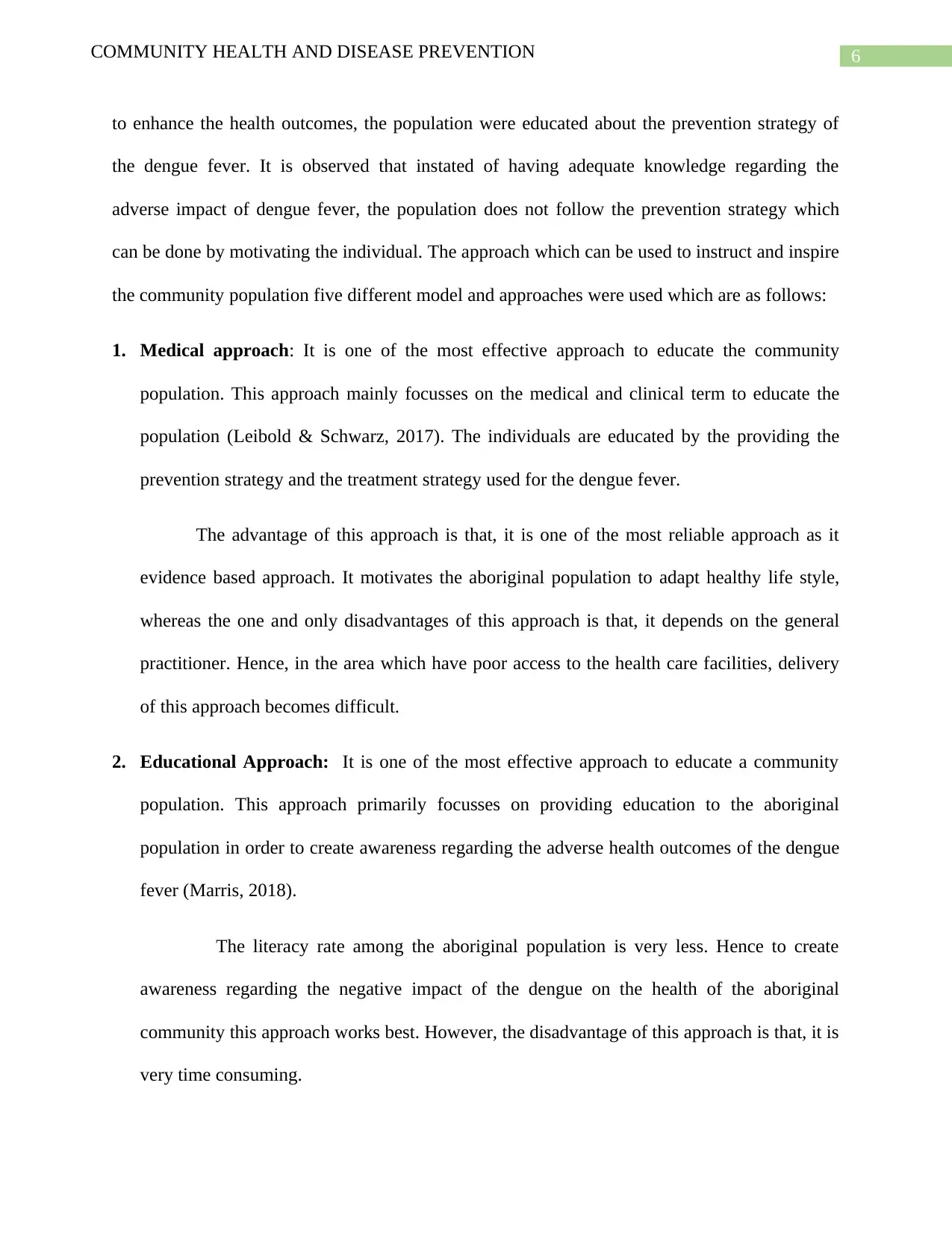
6COMMUNITY HEALTH AND DISEASE PREVENTION
to enhance the health outcomes, the population were educated about the prevention strategy of
the dengue fever. It is observed that instated of having adequate knowledge regarding the
adverse impact of dengue fever, the population does not follow the prevention strategy which
can be done by motivating the individual. The approach which can be used to instruct and inspire
the community population five different model and approaches were used which are as follows:
1. Medical approach: It is one of the most effective approach to educate the community
population. This approach mainly focusses on the medical and clinical term to educate the
population (Leibold & Schwarz, 2017). The individuals are educated by the providing the
prevention strategy and the treatment strategy used for the dengue fever.
The advantage of this approach is that, it is one of the most reliable approach as it
evidence based approach. It motivates the aboriginal population to adapt healthy life style,
whereas the one and only disadvantages of this approach is that, it depends on the general
practitioner. Hence, in the area which have poor access to the health care facilities, delivery
of this approach becomes difficult.
2. Educational Approach: It is one of the most effective approach to educate a community
population. This approach primarily focusses on providing education to the aboriginal
population in order to create awareness regarding the adverse health outcomes of the dengue
fever (Marris, 2018).
The literacy rate among the aboriginal population is very less. Hence to create
awareness regarding the negative impact of the dengue on the health of the aboriginal
community this approach works best. However, the disadvantage of this approach is that, it is
very time consuming.
to enhance the health outcomes, the population were educated about the prevention strategy of
the dengue fever. It is observed that instated of having adequate knowledge regarding the
adverse impact of dengue fever, the population does not follow the prevention strategy which
can be done by motivating the individual. The approach which can be used to instruct and inspire
the community population five different model and approaches were used which are as follows:
1. Medical approach: It is one of the most effective approach to educate the community
population. This approach mainly focusses on the medical and clinical term to educate the
population (Leibold & Schwarz, 2017). The individuals are educated by the providing the
prevention strategy and the treatment strategy used for the dengue fever.
The advantage of this approach is that, it is one of the most reliable approach as it
evidence based approach. It motivates the aboriginal population to adapt healthy life style,
whereas the one and only disadvantages of this approach is that, it depends on the general
practitioner. Hence, in the area which have poor access to the health care facilities, delivery
of this approach becomes difficult.
2. Educational Approach: It is one of the most effective approach to educate a community
population. This approach primarily focusses on providing education to the aboriginal
population in order to create awareness regarding the adverse health outcomes of the dengue
fever (Marris, 2018).
The literacy rate among the aboriginal population is very less. Hence to create
awareness regarding the negative impact of the dengue on the health of the aboriginal
community this approach works best. However, the disadvantage of this approach is that, it is
very time consuming.
Secure Best Marks with AI Grader
Need help grading? Try our AI Grader for instant feedback on your assignments.
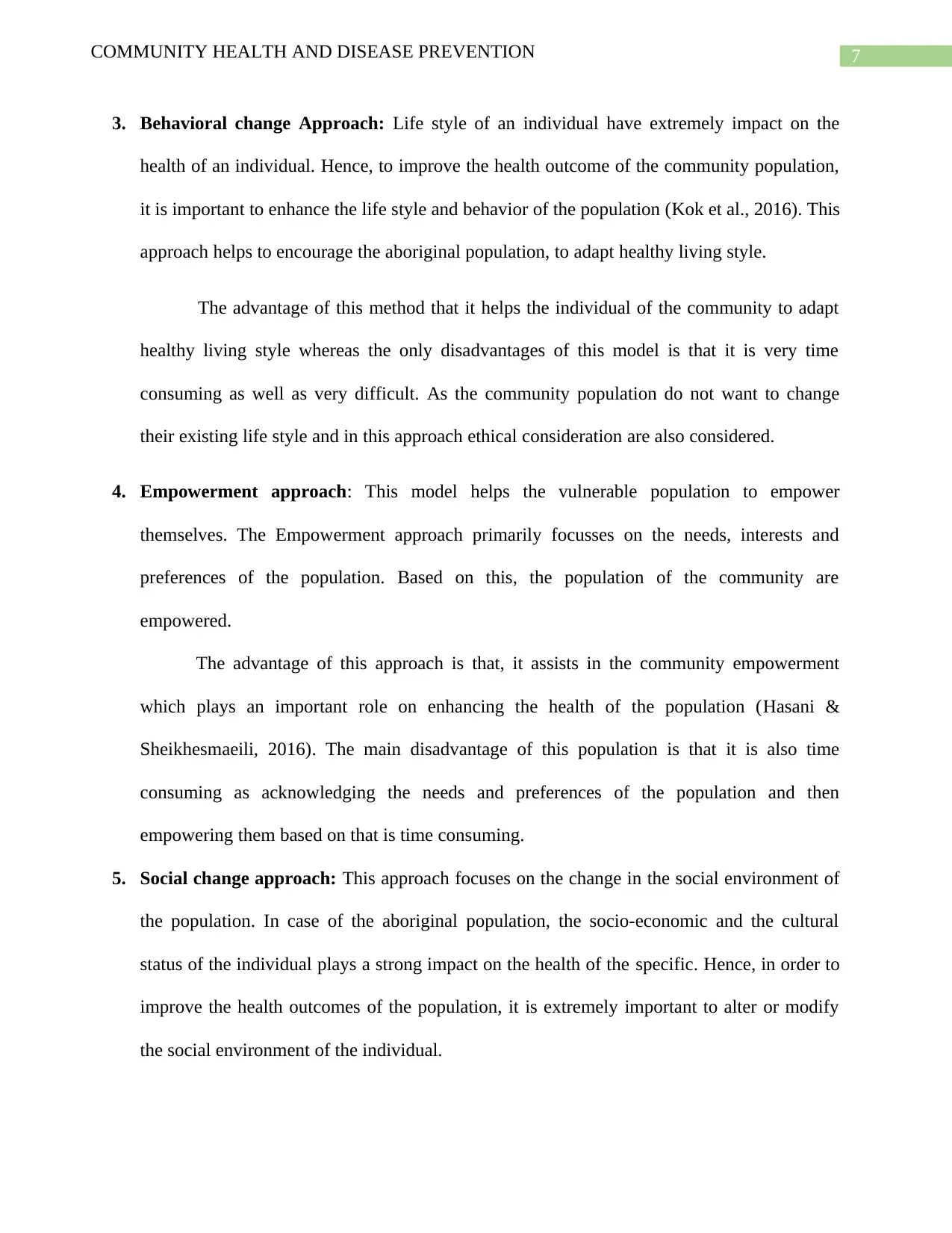
7COMMUNITY HEALTH AND DISEASE PREVENTION
3. Behavioral change Approach: Life style of an individual have extremely impact on the
health of an individual. Hence, to improve the health outcome of the community population,
it is important to enhance the life style and behavior of the population (Kok et al., 2016). This
approach helps to encourage the aboriginal population, to adapt healthy living style.
The advantage of this method that it helps the individual of the community to adapt
healthy living style whereas the only disadvantages of this model is that it is very time
consuming as well as very difficult. As the community population do not want to change
their existing life style and in this approach ethical consideration are also considered.
4. Empowerment approach: This model helps the vulnerable population to empower
themselves. The Empowerment approach primarily focusses on the needs, interests and
preferences of the population. Based on this, the population of the community are
empowered.
The advantage of this approach is that, it assists in the community empowerment
which plays an important role on enhancing the health of the population (Hasani &
Sheikhesmaeili, 2016). The main disadvantage of this population is that it is also time
consuming as acknowledging the needs and preferences of the population and then
empowering them based on that is time consuming.
5. Social change approach: This approach focuses on the change in the social environment of
the population. In case of the aboriginal population, the socio-economic and the cultural
status of the individual plays a strong impact on the health of the specific. Hence, in order to
improve the health outcomes of the population, it is extremely important to alter or modify
the social environment of the individual.
3. Behavioral change Approach: Life style of an individual have extremely impact on the
health of an individual. Hence, to improve the health outcome of the community population,
it is important to enhance the life style and behavior of the population (Kok et al., 2016). This
approach helps to encourage the aboriginal population, to adapt healthy living style.
The advantage of this method that it helps the individual of the community to adapt
healthy living style whereas the only disadvantages of this model is that it is very time
consuming as well as very difficult. As the community population do not want to change
their existing life style and in this approach ethical consideration are also considered.
4. Empowerment approach: This model helps the vulnerable population to empower
themselves. The Empowerment approach primarily focusses on the needs, interests and
preferences of the population. Based on this, the population of the community are
empowered.
The advantage of this approach is that, it assists in the community empowerment
which plays an important role on enhancing the health of the population (Hasani &
Sheikhesmaeili, 2016). The main disadvantage of this population is that it is also time
consuming as acknowledging the needs and preferences of the population and then
empowering them based on that is time consuming.
5. Social change approach: This approach focuses on the change in the social environment of
the population. In case of the aboriginal population, the socio-economic and the cultural
status of the individual plays a strong impact on the health of the specific. Hence, in order to
improve the health outcomes of the population, it is extremely important to alter or modify
the social environment of the individual.
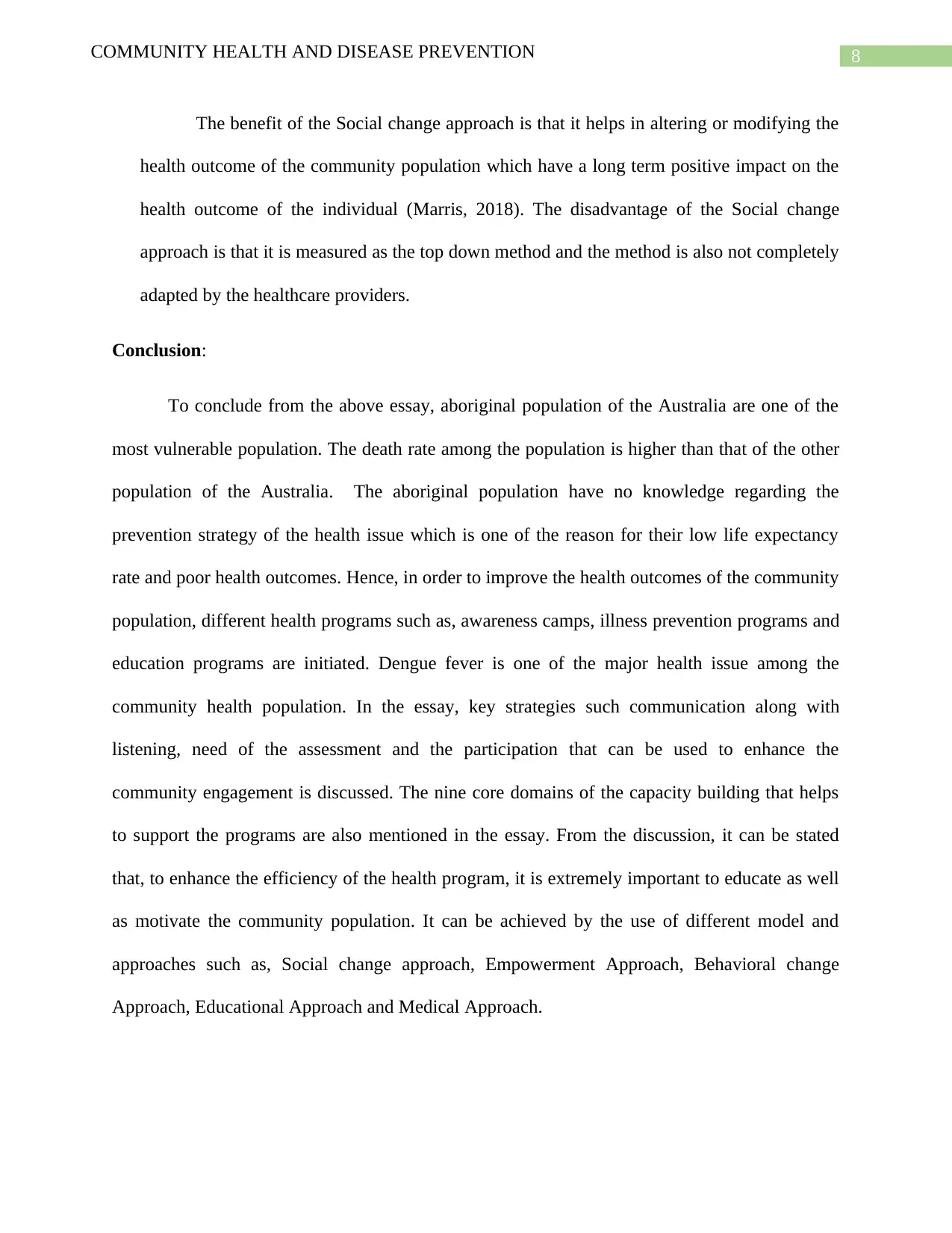
8COMMUNITY HEALTH AND DISEASE PREVENTION
The benefit of the Social change approach is that it helps in altering or modifying the
health outcome of the community population which have a long term positive impact on the
health outcome of the individual (Marris, 2018). The disadvantage of the Social change
approach is that it is measured as the top down method and the method is also not completely
adapted by the healthcare providers.
Conclusion:
To conclude from the above essay, aboriginal population of the Australia are one of the
most vulnerable population. The death rate among the population is higher than that of the other
population of the Australia. The aboriginal population have no knowledge regarding the
prevention strategy of the health issue which is one of the reason for their low life expectancy
rate and poor health outcomes. Hence, in order to improve the health outcomes of the community
population, different health programs such as, awareness camps, illness prevention programs and
education programs are initiated. Dengue fever is one of the major health issue among the
community health population. In the essay, key strategies such communication along with
listening, need of the assessment and the participation that can be used to enhance the
community engagement is discussed. The nine core domains of the capacity building that helps
to support the programs are also mentioned in the essay. From the discussion, it can be stated
that, to enhance the efficiency of the health program, it is extremely important to educate as well
as motivate the community population. It can be achieved by the use of different model and
approaches such as, Social change approach, Empowerment Approach, Behavioral change
Approach, Educational Approach and Medical Approach.
The benefit of the Social change approach is that it helps in altering or modifying the
health outcome of the community population which have a long term positive impact on the
health outcome of the individual (Marris, 2018). The disadvantage of the Social change
approach is that it is measured as the top down method and the method is also not completely
adapted by the healthcare providers.
Conclusion:
To conclude from the above essay, aboriginal population of the Australia are one of the
most vulnerable population. The death rate among the population is higher than that of the other
population of the Australia. The aboriginal population have no knowledge regarding the
prevention strategy of the health issue which is one of the reason for their low life expectancy
rate and poor health outcomes. Hence, in order to improve the health outcomes of the community
population, different health programs such as, awareness camps, illness prevention programs and
education programs are initiated. Dengue fever is one of the major health issue among the
community health population. In the essay, key strategies such communication along with
listening, need of the assessment and the participation that can be used to enhance the
community engagement is discussed. The nine core domains of the capacity building that helps
to support the programs are also mentioned in the essay. From the discussion, it can be stated
that, to enhance the efficiency of the health program, it is extremely important to educate as well
as motivate the community population. It can be achieved by the use of different model and
approaches such as, Social change approach, Empowerment Approach, Behavioral change
Approach, Educational Approach and Medical Approach.
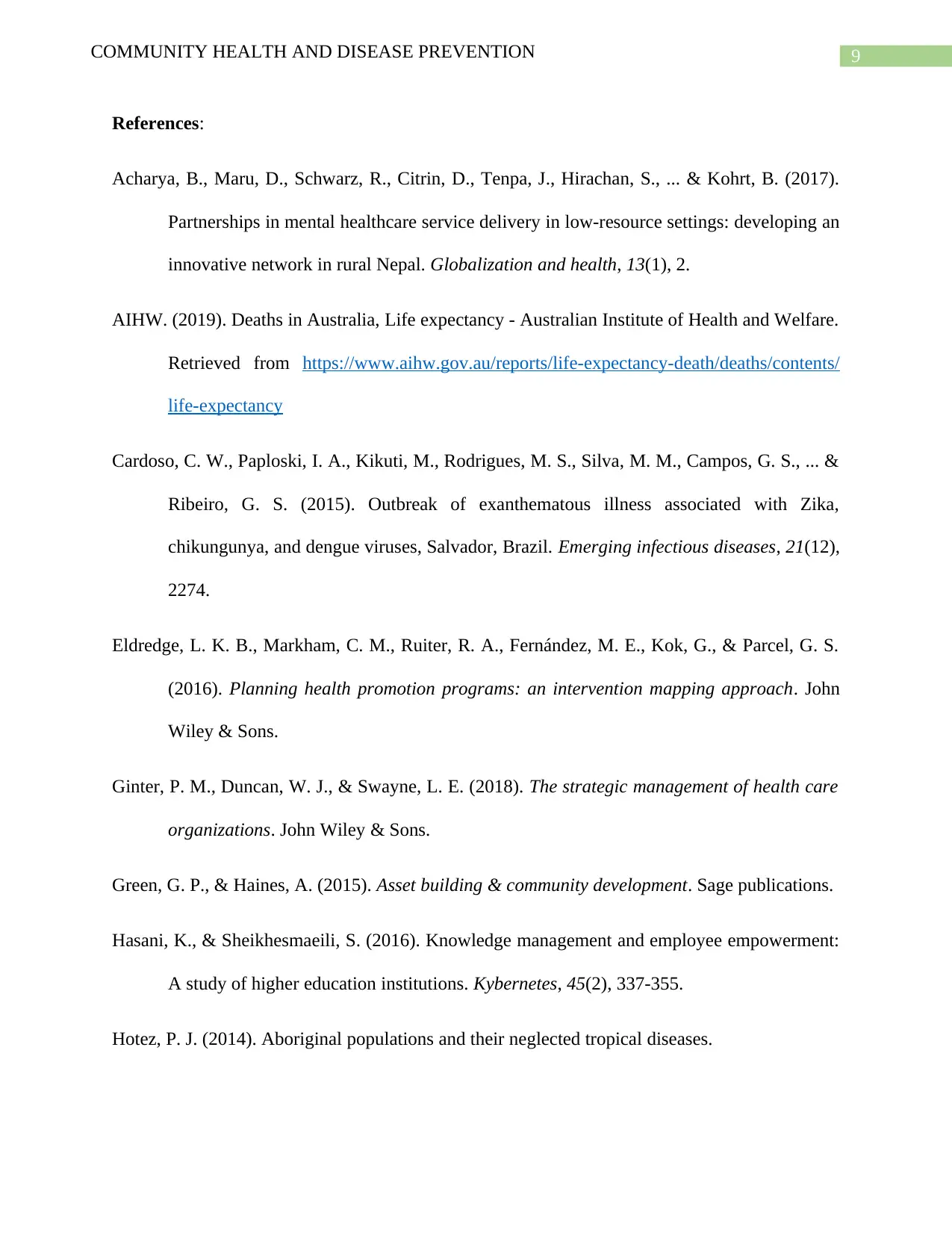
9COMMUNITY HEALTH AND DISEASE PREVENTION
References:
Acharya, B., Maru, D., Schwarz, R., Citrin, D., Tenpa, J., Hirachan, S., ... & Kohrt, B. (2017).
Partnerships in mental healthcare service delivery in low-resource settings: developing an
innovative network in rural Nepal. Globalization and health, 13(1), 2.
AIHW. (2019). Deaths in Australia, Life expectancy - Australian Institute of Health and Welfare.
Retrieved from https://www.aihw.gov.au/reports/life-expectancy-death/deaths/contents/
life-expectancy
Cardoso, C. W., Paploski, I. A., Kikuti, M., Rodrigues, M. S., Silva, M. M., Campos, G. S., ... &
Ribeiro, G. S. (2015). Outbreak of exanthematous illness associated with Zika,
chikungunya, and dengue viruses, Salvador, Brazil. Emerging infectious diseases, 21(12),
2274.
Eldredge, L. K. B., Markham, C. M., Ruiter, R. A., Fernández, M. E., Kok, G., & Parcel, G. S.
(2016). Planning health promotion programs: an intervention mapping approach. John
Wiley & Sons.
Ginter, P. M., Duncan, W. J., & Swayne, L. E. (2018). The strategic management of health care
organizations. John Wiley & Sons.
Green, G. P., & Haines, A. (2015). Asset building & community development. Sage publications.
Hasani, K., & Sheikhesmaeili, S. (2016). Knowledge management and employee empowerment:
A study of higher education institutions. Kybernetes, 45(2), 337-355.
Hotez, P. J. (2014). Aboriginal populations and their neglected tropical diseases.
References:
Acharya, B., Maru, D., Schwarz, R., Citrin, D., Tenpa, J., Hirachan, S., ... & Kohrt, B. (2017).
Partnerships in mental healthcare service delivery in low-resource settings: developing an
innovative network in rural Nepal. Globalization and health, 13(1), 2.
AIHW. (2019). Deaths in Australia, Life expectancy - Australian Institute of Health and Welfare.
Retrieved from https://www.aihw.gov.au/reports/life-expectancy-death/deaths/contents/
life-expectancy
Cardoso, C. W., Paploski, I. A., Kikuti, M., Rodrigues, M. S., Silva, M. M., Campos, G. S., ... &
Ribeiro, G. S. (2015). Outbreak of exanthematous illness associated with Zika,
chikungunya, and dengue viruses, Salvador, Brazil. Emerging infectious diseases, 21(12),
2274.
Eldredge, L. K. B., Markham, C. M., Ruiter, R. A., Fernández, M. E., Kok, G., & Parcel, G. S.
(2016). Planning health promotion programs: an intervention mapping approach. John
Wiley & Sons.
Ginter, P. M., Duncan, W. J., & Swayne, L. E. (2018). The strategic management of health care
organizations. John Wiley & Sons.
Green, G. P., & Haines, A. (2015). Asset building & community development. Sage publications.
Hasani, K., & Sheikhesmaeili, S. (2016). Knowledge management and employee empowerment:
A study of higher education institutions. Kybernetes, 45(2), 337-355.
Hotez, P. J. (2014). Aboriginal populations and their neglected tropical diseases.
Paraphrase This Document
Need a fresh take? Get an instant paraphrase of this document with our AI Paraphraser
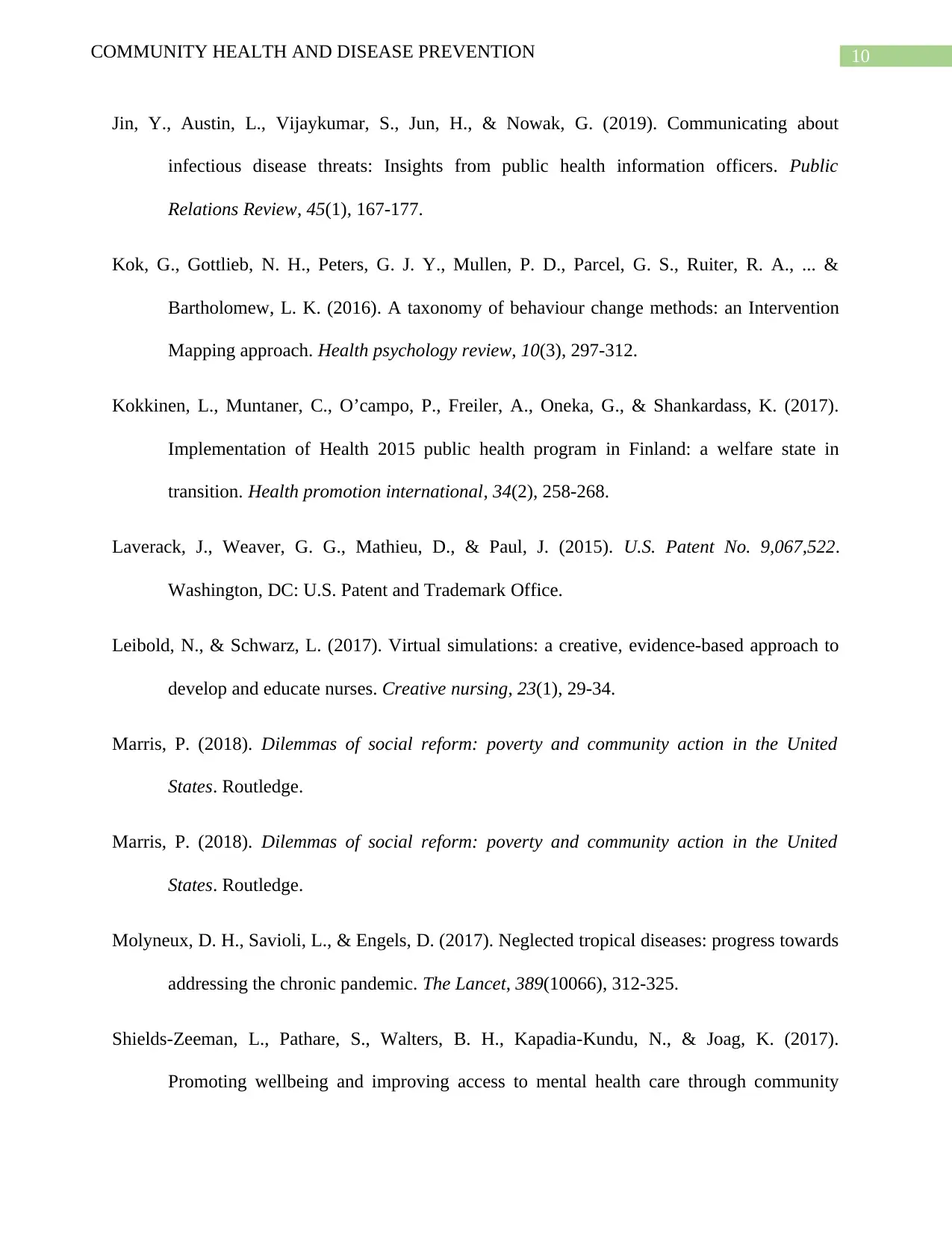
10COMMUNITY HEALTH AND DISEASE PREVENTION
Jin, Y., Austin, L., Vijaykumar, S., Jun, H., & Nowak, G. (2019). Communicating about
infectious disease threats: Insights from public health information officers. Public
Relations Review, 45(1), 167-177.
Kok, G., Gottlieb, N. H., Peters, G. J. Y., Mullen, P. D., Parcel, G. S., Ruiter, R. A., ... &
Bartholomew, L. K. (2016). A taxonomy of behaviour change methods: an Intervention
Mapping approach. Health psychology review, 10(3), 297-312.
Kokkinen, L., Muntaner, C., O’campo, P., Freiler, A., Oneka, G., & Shankardass, K. (2017).
Implementation of Health 2015 public health program in Finland: a welfare state in
transition. Health promotion international, 34(2), 258-268.
Laverack, J., Weaver, G. G., Mathieu, D., & Paul, J. (2015). U.S. Patent No. 9,067,522.
Washington, DC: U.S. Patent and Trademark Office.
Leibold, N., & Schwarz, L. (2017). Virtual simulations: a creative, evidence-based approach to
develop and educate nurses. Creative nursing, 23(1), 29-34.
Marris, P. (2018). Dilemmas of social reform: poverty and community action in the United
States. Routledge.
Marris, P. (2018). Dilemmas of social reform: poverty and community action in the United
States. Routledge.
Molyneux, D. H., Savioli, L., & Engels, D. (2017). Neglected tropical diseases: progress towards
addressing the chronic pandemic. The Lancet, 389(10066), 312-325.
Shields-Zeeman, L., Pathare, S., Walters, B. H., Kapadia-Kundu, N., & Joag, K. (2017).
Promoting wellbeing and improving access to mental health care through community
Jin, Y., Austin, L., Vijaykumar, S., Jun, H., & Nowak, G. (2019). Communicating about
infectious disease threats: Insights from public health information officers. Public
Relations Review, 45(1), 167-177.
Kok, G., Gottlieb, N. H., Peters, G. J. Y., Mullen, P. D., Parcel, G. S., Ruiter, R. A., ... &
Bartholomew, L. K. (2016). A taxonomy of behaviour change methods: an Intervention
Mapping approach. Health psychology review, 10(3), 297-312.
Kokkinen, L., Muntaner, C., O’campo, P., Freiler, A., Oneka, G., & Shankardass, K. (2017).
Implementation of Health 2015 public health program in Finland: a welfare state in
transition. Health promotion international, 34(2), 258-268.
Laverack, J., Weaver, G. G., Mathieu, D., & Paul, J. (2015). U.S. Patent No. 9,067,522.
Washington, DC: U.S. Patent and Trademark Office.
Leibold, N., & Schwarz, L. (2017). Virtual simulations: a creative, evidence-based approach to
develop and educate nurses. Creative nursing, 23(1), 29-34.
Marris, P. (2018). Dilemmas of social reform: poverty and community action in the United
States. Routledge.
Marris, P. (2018). Dilemmas of social reform: poverty and community action in the United
States. Routledge.
Molyneux, D. H., Savioli, L., & Engels, D. (2017). Neglected tropical diseases: progress towards
addressing the chronic pandemic. The Lancet, 389(10066), 312-325.
Shields-Zeeman, L., Pathare, S., Walters, B. H., Kapadia-Kundu, N., & Joag, K. (2017).
Promoting wellbeing and improving access to mental health care through community
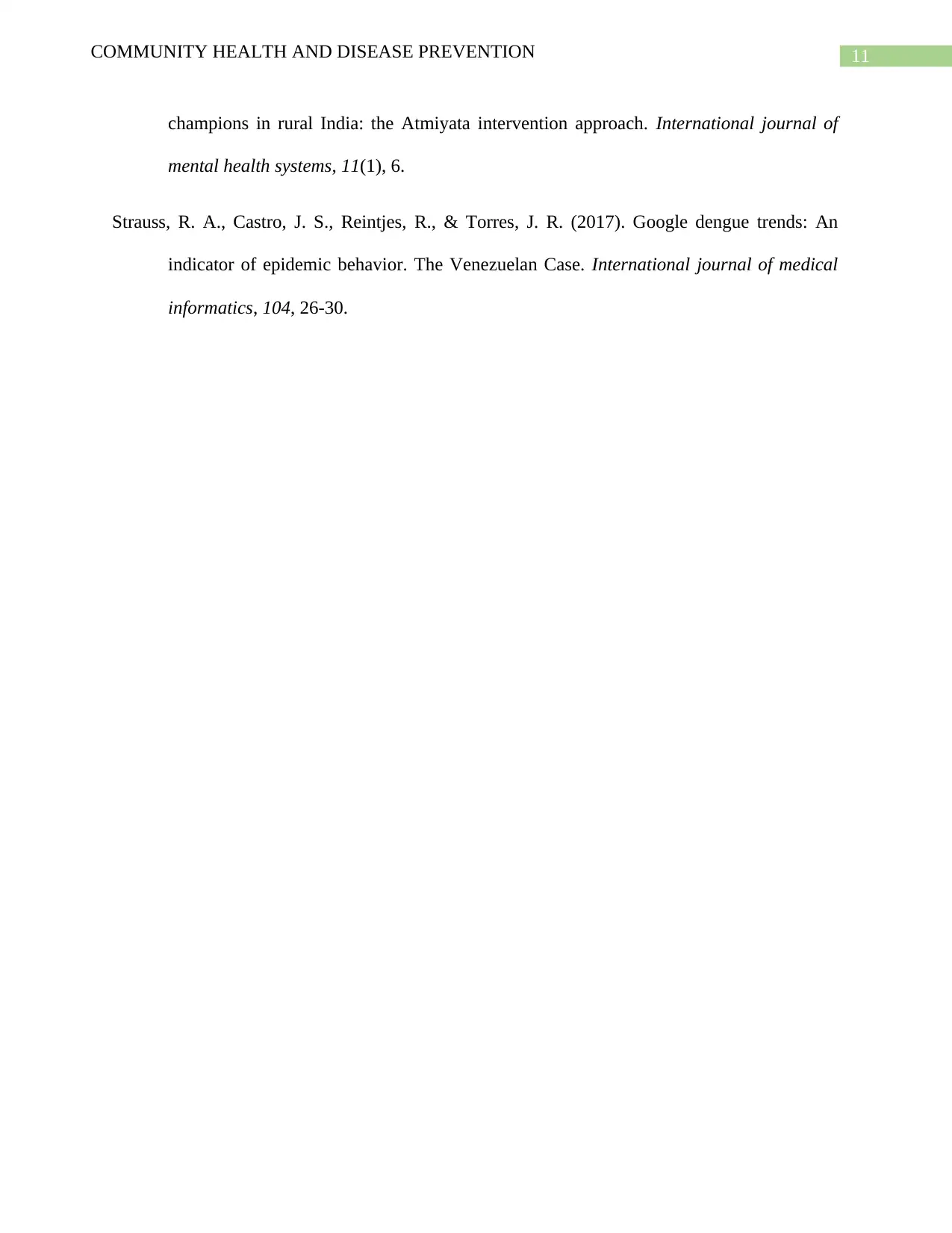
11COMMUNITY HEALTH AND DISEASE PREVENTION
champions in rural India: the Atmiyata intervention approach. International journal of
mental health systems, 11(1), 6.
Strauss, R. A., Castro, J. S., Reintjes, R., & Torres, J. R. (2017). Google dengue trends: An
indicator of epidemic behavior. The Venezuelan Case. International journal of medical
informatics, 104, 26-30.
champions in rural India: the Atmiyata intervention approach. International journal of
mental health systems, 11(1), 6.
Strauss, R. A., Castro, J. S., Reintjes, R., & Torres, J. R. (2017). Google dengue trends: An
indicator of epidemic behavior. The Venezuelan Case. International journal of medical
informatics, 104, 26-30.
1 out of 12
![[object Object]](/_next/static/media/star-bottom.7253800d.svg)





